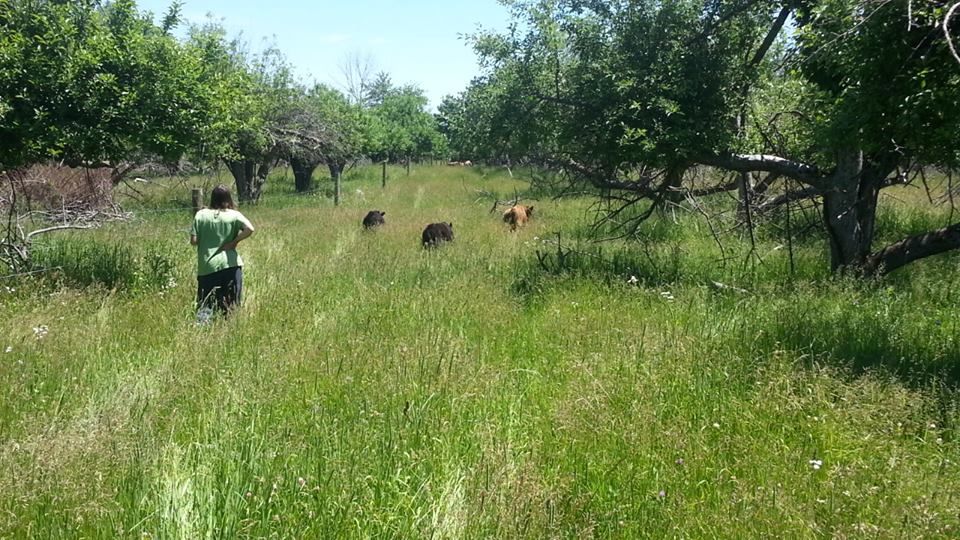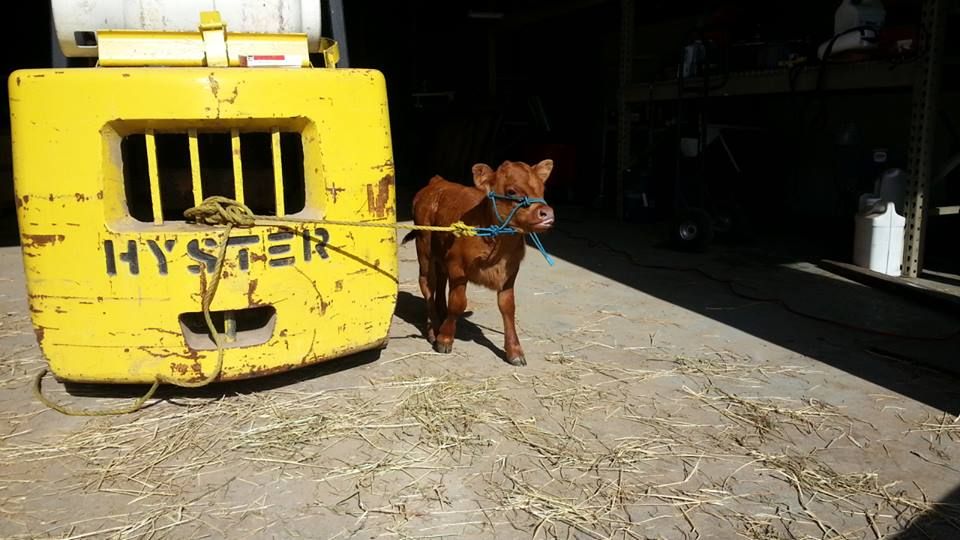|
|
Post by lakeportfarms on Jun 23, 2014 13:16:37 GMT -5
Here is an example of what managed intensive grazing does for us...after a cool wet spring with a lot of snowmelt, we haven't had a lot of rain since then, However we still have a lot of grass for the many cows to eat. Sheril is on her way out to give them a new strip at the end of this particular pasture. The grass they grazed a month ago has made a nice recovery and is green and continuing to grow, and they'll be back on it in 30 days or so where it will be knee high once again. The grass they've recently grazed looks burned up now with the lack of rain, but with some expected tonight and Tuesday it will hopefully start to recover well. There is a back line to prevent them from re-grazing it. When we have the fairly dry weather, it is important to move the back line more frequently to give the grass the best possible chance to recover.  And just for the fun of it, one of our newest calves, a chondro pos red heifer out of Timber and Wren. We dehorned, tagged, etc... Willow along with 8 other calves Saturday afternoon so it was a busy day. She's a pretty cute and spunky little heifer!  |
|
|
|
Post by carragheendexters on Jun 23, 2014 15:06:29 GMT -5
Gorgeous heifer Hans, and I love all that wonderful pasture. Rain is definitely the controlling factor when growing pasture, but by rotating the way you do it certainly improves the chances of regrowth. It obviously works.
|
|
|
|
Post by lakeportfarms on Jun 23, 2014 19:16:32 GMT -5
Thanks Louise...we're huge proponents of it, and fortunately Sheril is a teacher and so we/she can move them frequently during the summer months. The only downside is that we can't just go out and visit with the cows without them throwing a fit if we don't pick up a line. It gets pretty noisy if we don't think they're ready for another strip!
This year we're going to try and finally get all the big branches we've trimmed off the apple trees picked up, so we can get in with a spreader and lime and possibly fertilize for next years grazing.
|
|
|
|
Post by carragheendexters on Jun 23, 2014 20:00:24 GMT -5
Sounds like a good plan. Have you the results of a recent soil test? Do you have acid soil?
Do you guys ever incorporate a selenium dressing with your fertiliser to help prevent Se deficiency?
We add molybdenum as we are low in our area and it helps the clover to grow.
|
|
|
|
Post by lakeportfarms on Jun 23, 2014 21:25:29 GMT -5
Yes we do have some areas that would benefit with a lime application, though it's been a few years since we had the soil tests done. We thought we'd be done with the branches long before!
Gene, we do cut up the branches for our own use (firewood), but it's been difficult to handle it after it's been cut. Last year I purchased a bunch of apple crates, so we're using those to hold the firewood. I'd give away the smaller branches but I really don't want people I don't know walking around the orchard. So the smaller branches will be pushed into a pile here and there and burned on a cold winter day.
|
|
|
|
Post by wvdexters on Jun 24, 2014 9:29:59 GMT -5
Very pretty fields Hans. They sure look different than the photos we were sharing a few mos back huh! LOL
Nice heifer too!!!
|
|
|
|
Post by lakeportfarms on Jun 25, 2014 4:47:19 GMT -5
Thanks Karrie, though I doubt the grass will get as deep as the snow was, it sure is a nice change, and the cows appreciate it too!
|
|
dexterlady
member
Wife, mother of two daughters and five grand children
Posts: 647
|
Post by dexterlady on Jun 25, 2014 12:05:55 GMT -5
Hans, your grass looks so good....Your orchard is just beautiful.....I wish I could do this to our fifteen acres...How many acres are you doing this with?....Boy that is some long grass....We are finally getting some much needed rain....Don't know if it will get us out of our drought but it sure is helping....Your heifer is just adorable.....
|
|
dexterlady
member
Wife, mother of two daughters and five grand children
Posts: 647
|
Post by dexterlady on Jun 25, 2014 12:09:45 GMT -5
Hans, your grass looks so good....Your orchard is just beautiful.....I wish I could do this to our fifteen acres...How many acres are you doing this with?....Boy that is some long grass....We are finally getting some much needed rain....Don't know if it will get us out of our drought but it sure is helping....Your heifer is just adorable.....
|
|
|
|
Post by lakeportfarms on Jun 25, 2014 20:53:59 GMT -5
Donna, we are doing managed grazing on 38 of the acres, though with winter sacrifice areas, drives, a large building and a big pond among other things that cut into the available forage, it probably works out more like 30 acres. So far this year (one month) we've been running around 97 Dexters of various ages, and 28 Scottish Highlands on this acreage alone without feeding any hay. We have 1-1/2 weeks left on the first rotation, and the pastures will be ready to start again on the second rotation, though I doubt the grass will reach that length the next time they roll through. Now that the spring grass growth is waning, we'll be moving the Highlands to some adjacent acreage which is unimproved to start eating down the brush and grass, and to preserve our better forage for the Dexters. Eventually (a year or two) we will have an additonal 60 acres improved enough to start doing the managed grazing on those acres.
One of the biggest benefits to the managed grazing is when it has been a bit dry, the grass that has some length is still recovering without any grazing or foot traffic, which helps preserve the moisture. When it does rain, the grass recovers far better when it has been undisturbed for such a length of time.
|
|
|
|
Post by wildberryfarm on Jun 25, 2014 21:32:35 GMT -5
So that's 125 cows on 30 acres...oh my word. I would really like to pick your brain about this more. Maybe next time we visit I could bring a map of our property and you could tell me what you think? It is only ten acres, some woods, pond, garden, outbuildings etc, so not very much for pasture. We do have a thus-far empty 2 acres in the front, though, that is beautiful grass hay (has been hayed/maintained by a neighbor since before we moved in here). Hans do you think we could do it on such a small scale?
|
|
|
|
Post by lakeportfarms on Jun 26, 2014 4:58:49 GMT -5
Diana, It works great on a small scale. Violet (and Vannessa) is well trained to the single hot wire, and Nolan is probably tall enough now that it would contain him too. You would use significantly smaller strips than we do, but I'm sure we could work out a map for your property. You can even do it somewhat with the horses, though they're a bit more of a challenge. The two acres you have would probably be enough for all of them (cows, not horses!) most of the summer unless it got really hot and dry for a month or more. You'll love our method of moving water! Coolers on wheels and the auto-waterer fits perfectly on them. Then when "Kobe time" comes, you borrow it for a few hours to bring him home again  Now you see why Sheril was telling you I'm a fencing fool...lol. I'm trying to get better permanent fencing up in a different design to help move them from pasture to pasture more effectively. And of course with so many and in so many different herds, we need more secure (and easily repairable if necessary) fencing anyway. |
|
|
|
Post by Dahdo on Jun 26, 2014 10:45:31 GMT -5
Good looking grass and have you got a name for that calf yet? I like Hyster. I call my system MMIG...micro management intensive grazing. Basically, a small of herd of small cows on a small farm.  ? We only have ten animals, but I give them a new strip of grass twice a day right now to try an minimize the waste from trampling. We go to a new paddock (defined by polywire) every 3-4 days to get away from the parasites and keep the cows from taking a second bite as the grass begins regrowth. As you can see in the picture, the grass has gotten away from us this year. Hope we can make hay soon, the forecast is for 80s next week, but it's raining now! Attachments:
|
|
|
|
Post by lakeportfarms on Jun 26, 2014 21:04:07 GMT -5
Great photos Dave and Sheri! Like you Dave, we move them 2, or often 3 or 4 times/day. And the back line gets moved every couple of days at the most. Fortunately as a teacher Sheril has her days off during the majority of our grazing season, but we've done a lot to make it possible to move them in a matter of minutes if necessary by setting up multiple days of moves in advance when we have the opportunity.
Sheri your pastures (when you do reach your stocking rate) are going to be outstanding. Rather than the netting or trying to run multiple hot wires, we let the smaller calves (even some of our shortie yearlings)duck the wire into the tall grass. When giving them such small strips with a back line so close behind, sometimes less than 20 feet, there is no way we could keep playful calves from tearing out the lower wire(s) and therefore opening it up to the larger cows and ending up with a tangled mess of expensive poly wire. I think the wire is at about 28-30" or so in height. If the somewhat young ones try to duck it, it snaps on their back and they've only made it into a narrow strip before there is another wire waiting to do the same thing to them. They usually just hang out there for a few hours until we roll it up for the rest of the herd, and they learn the lesson better that way.
|
|
|
|
Post by lakeportfarms on Jun 27, 2014 5:09:39 GMT -5
A perfect description...the young and the small who have less of a chance to compete for the best grass get to the front of the food line.
Calves also have a natural tendency to bed down in the tall grass, where they feel safe even if they are away from their mother for a bit. Usually the newborns will be just on the other side of the first hot wire, where the 2-5 month olds will venture much further away and explore the pasture.
|
|